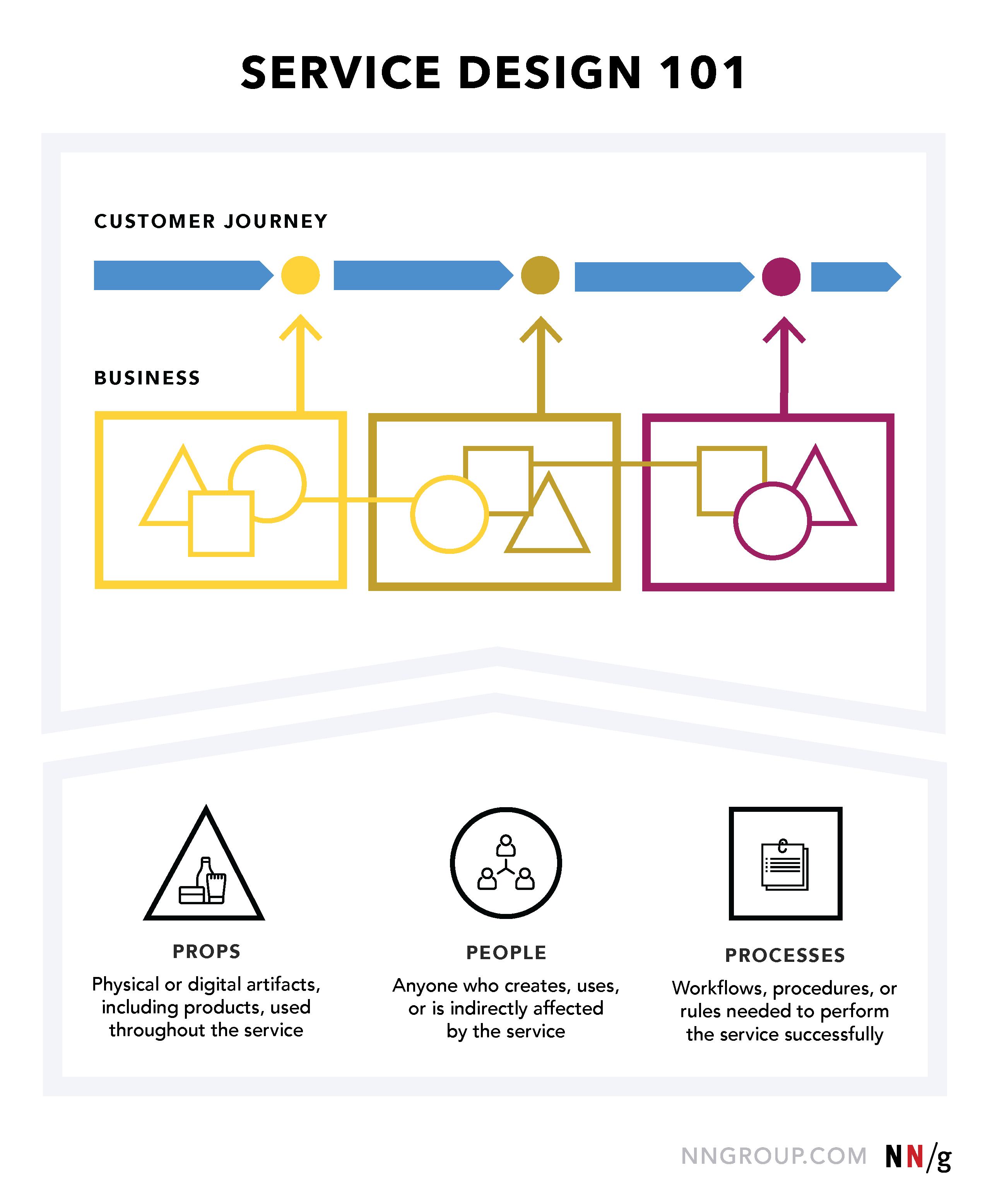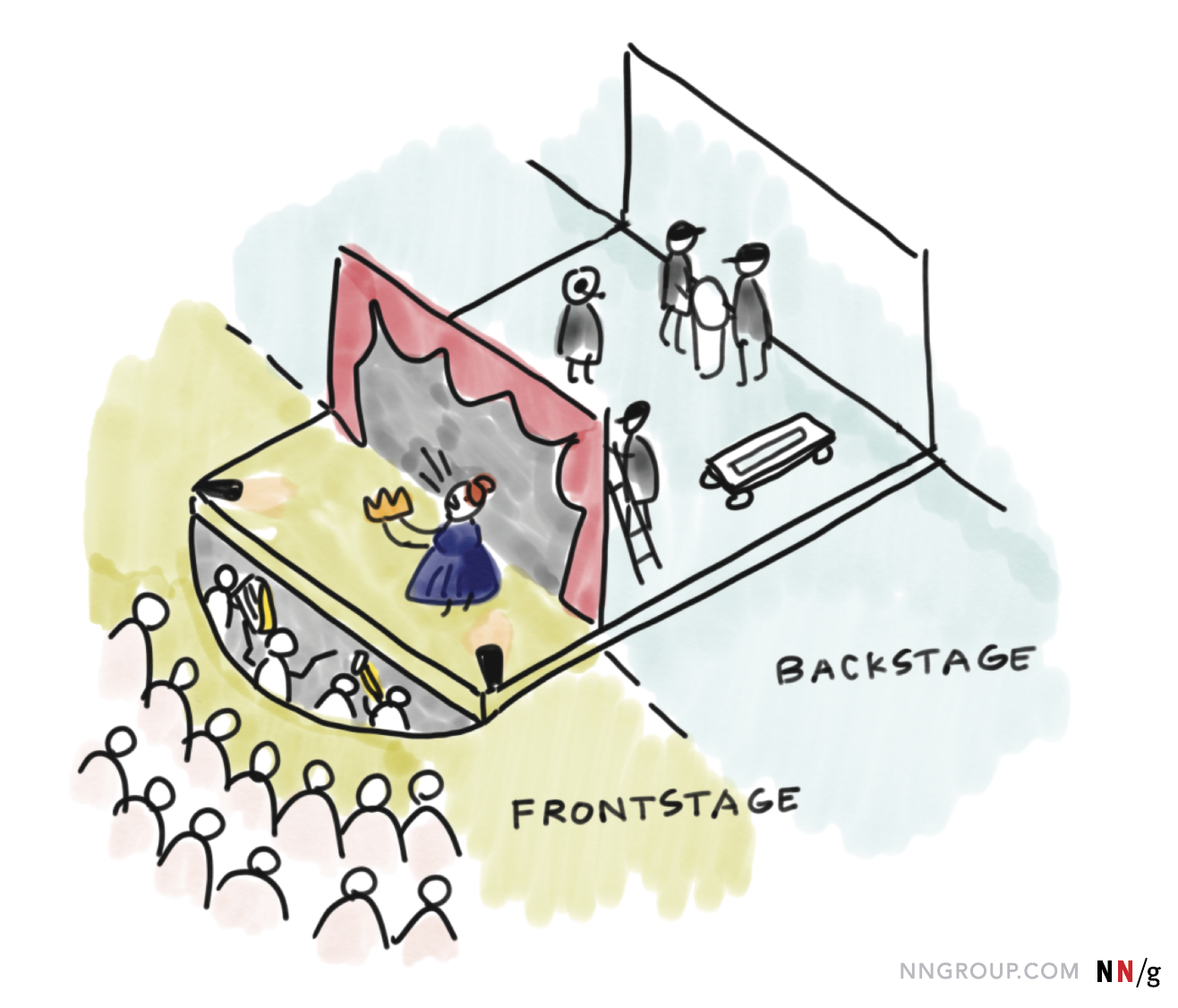Service design improves the user and employee experience by designing, aligning, and optimizing an organization’s operations to better support the customer journey.
What is a service?
Traditional economics makes a clear distinction between goods and services, with goods being tangible and consumables (eg: pens, sunglasses, or shoes). Services are intangible instant exchanges that do not result in ownership (eg: medical care, postal services, or public transportation).
Today, there is no longer a clear distinction between goods and services. There is a continuum of goods and services with a large number of combined products and services in between. For example Songs (mp3 files) are products that can be accessed through services like Spotify or Apple Music. For a user, the difference between owning a sound file and a product and service that streams a song can be close to the same, while behind the scenes they are quite different.

As services become more complex, so does the need to support them. Sophisticated user experiences are often broken by internal organizational flaws, the weak link in the ecosystem. Example: The last time you called the support line, did you provide your personal information only to be transferred to another agent who asked you to repeat the exact information you provided? This pain point stems from internal process flaws created by the lack of service design.
Service Design History
The term “service design” was coined by Lynn Shostack in 1982. Shostack advises organizations to understand how behind-the-scenes processes interact because “leaving service to individual talents and managing parts rather than the overall company is more fragile and creates a sense of Services that are slow to respond to market needs and opportunities.”
This is still true today, but the responsibility is not just the operations and management of twenty years ago, the practice of service design is the responsibility of the entire organization.
Definition of Service Design
Most organizations are centered on products and delivery channels, many organizational resources (time, budget, logistics) are spent on customer-facing outputs, internal processes (including the experience of the organization’s employees) are ignored, and service design focuses on these internal processes.
Definition: Service design is the activity of planning and organizing business resources (people, props, and processes) in order to (1) directly improve the experience of employees and (2) indirectly improve the experience of customers.
Imagine a restaurant with a range of employees: the owner, the waiter, the shop, and the chef. Service design focuses on how a restaurant operates and delivers the food it promises – from sourcing and receiving ingredients, to new chefs, to waiters – chefs communicating about diners’ allergies. Every moving part plays a role in the food that arrives on the restaurant’s plate, even if it’s not a direct part of their experience. Service designs can be mapped using service blueprints.

Components of “Service Design”
UX design is made up of multiple “components”: visual, functional and command, copywriting, information architecture, and more. Not only must each component be properly designed, but they must also make up an overall user experience, and the same is true of service design.
It consists of several components, each of which must be properly designed and integrated into a whole.
The three main components of service design are:
(1) person
This section includes anyone creating or using the Service, as well as individuals who may be indirectly affected by the Service.
E.g:
- Staff;
- client;
- Customers encountered throughout the service process;
- Partner.
(2) props
This section refers to the physical or digital “tools” (including products) required to successfully perform the service.
E.g:
- Physical space: storefront, cashier window, meeting room;
- The digital environment in which the service is provided: web pages, blogs, social media;
- Hardware and software and accessories: digital versions of documents, physical products.
(3) Process
These are all the workflows, procedures, and ceremonies performed by employees or users throughout this service.
Examples include:
- withdraw money from an ATM;
- interview new employees;
- shared documents;
- Solve puzzles by helping.
Returning to the restaurant example, people are farmers who grow crops, restaurant managers, chefs, shopkeepers, and waiters. Tools include (amongst others): Kitchen, Ingredients, POS Software, and Uniforms. The process includes employees clocking in, servers placing orders, cleaning dishes and storing food.
front and back
The components of service can be divided into front-end and back-end, depending on whether the customer sees them or not. Think of a theatrical performance, where the audience sees everything in front of the screen: actors, costumes, orchestra, and sets. Behind the scenes, however, is an entire ecosystem: directors, stage managers, lighting adjusters, and set designers.

While the audience never sees the backstage, it plays a vital role in structuring the audience experience. In a restaurant, what happens in the kitchen determines the food on your table.
Frontend components include:
- aisle;
- product;
- Contact point;
- interface.
Backend components include:
- policy;
- Technology;
- infrastructure;
- system.
Service Design and Designing a Service
Service design is not just about designing a service, service design addresses how an organization accomplishes a certain job – taking into account the “employee experience”. Designing a service addresses the touchpoints that create the customer journey—thinking about “the user’s experience.”
As a parallel, every software application has a user interface, no matter how rudimentary. However, writing code to create a two-way product-oriented interface cannot be called the “UI design process”. Similarly, even if a user interface is created through a careful design process, it is not a product of “UX design” unless it has the user’s experience in mind.
As UX designers, why do we need to care about service design and “employee experience”?
An organization’s back-office processes (how we perform actions internally) have as much impact on the overall user experience as the visible interaction points the user encounters, if not more. If the waiter doesn’t successfully communicate the allergy to the chef, the diners could be consuming food with serious consequences. If a restaurant is overcrowded but has a systematic procedure for clearing tables and assigning seats, customers don’t have to wait or know it’s overcrowded in the first place.
Benefits of Service Design
Most organizational resources (time, budget, logistics) are spent on customer-facing outputs, while internal processes (including the experience of the organization’s employees) are neglected. This disconnect has given rise to a common opinion: One hand doesn’t know what the other is doing.
Service design bridges this organizational gap by:
- Expose conflict: Business models and service design models often conflict because business models do not always align with the services an organization provides. Service design triggers think and provide the context of the system that needs to be in place in order to adequately provide the service throughout the life of the product (in some cases, even in others).
- Facilitate heated dialogue: Focused discussions of procedures and policies expose weaknesses and dislocations, enabling organizations to develop collaborative and cross-functional solutions.
- Reduce redundancies from a bird’s-eye view: Outlining the full cycle of an internal service process gives a company a bird’s-eye view of its service ecosystem, whether within a large service area or across multiple business lines. This process helps identify where duplication of work occurs, where it can lead to employee frustration, and where resources are wasted. Eliminating redundancies saves effort, increases employee efficiency, and reduces costs.
- Forming relationships: Service design helps align internal terms of service (eg: roles, back-office roles, processes, and workflows) with equivalent front-office personnel, returning to our original example, the information provided to an agent through service design Should be available to all other agents interacting with the same client.
Epilogue
When back-office problems exist, they have front-office consequences: poor service, disappointed customers, inconsistent channels. Simplifying back-office processes improve the employee experience, which in turn enables them to create a better user experience.

